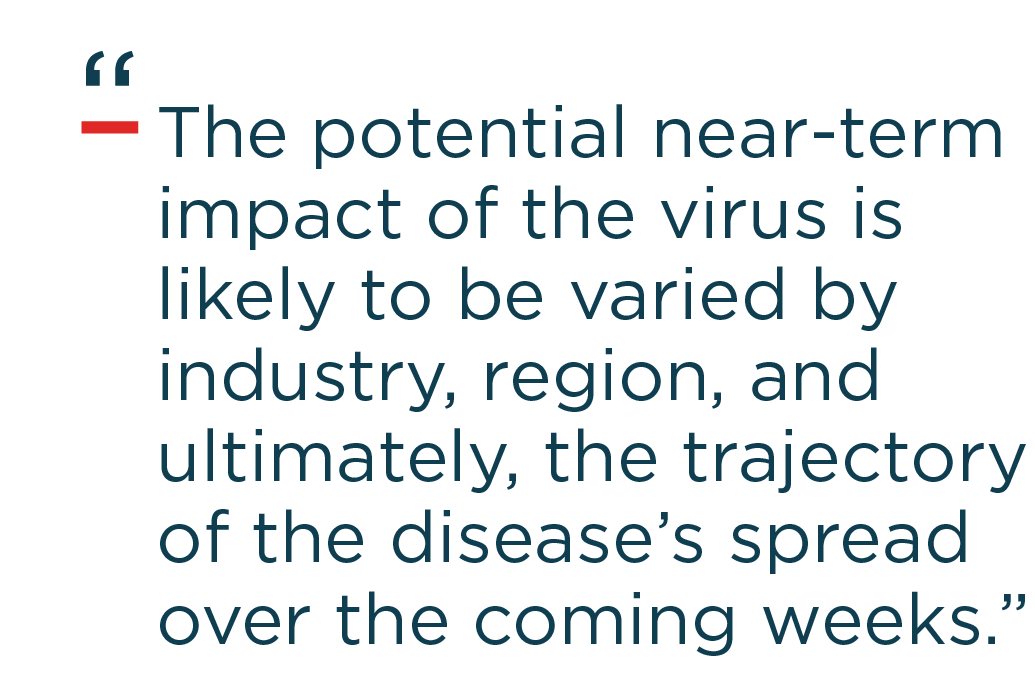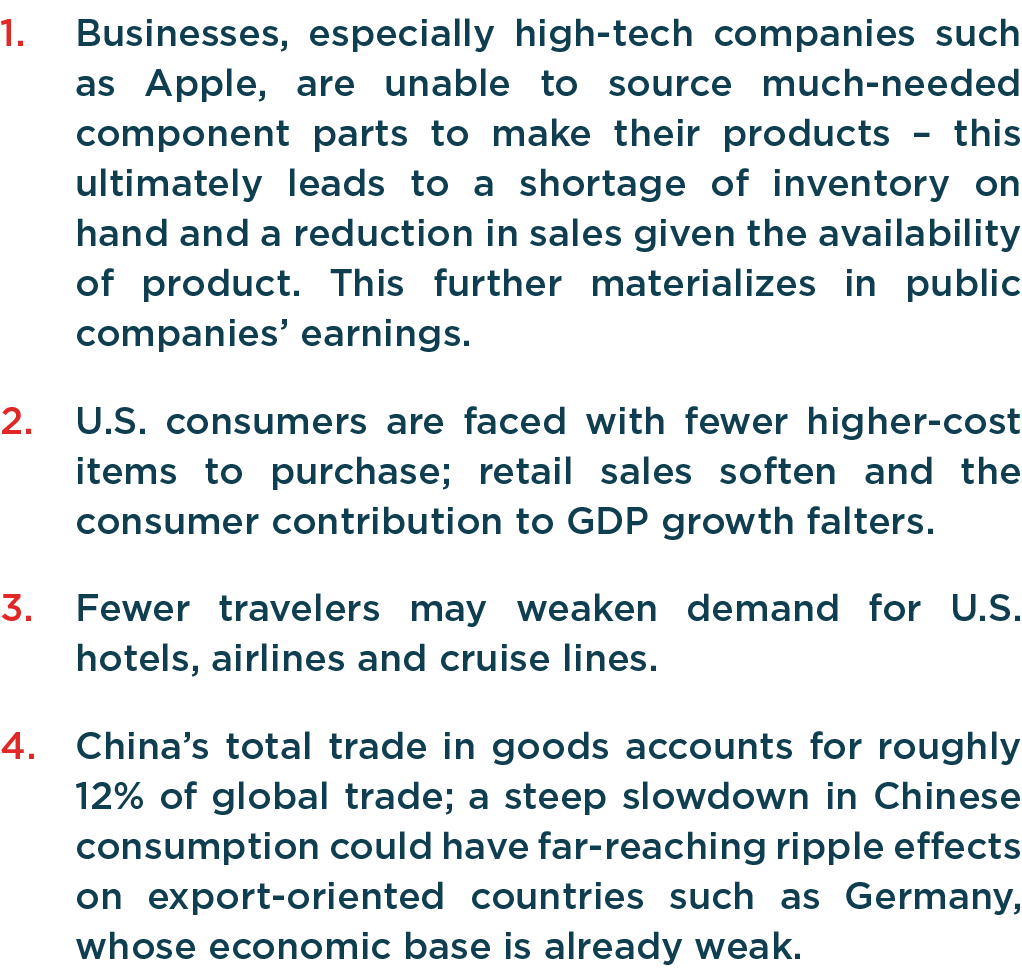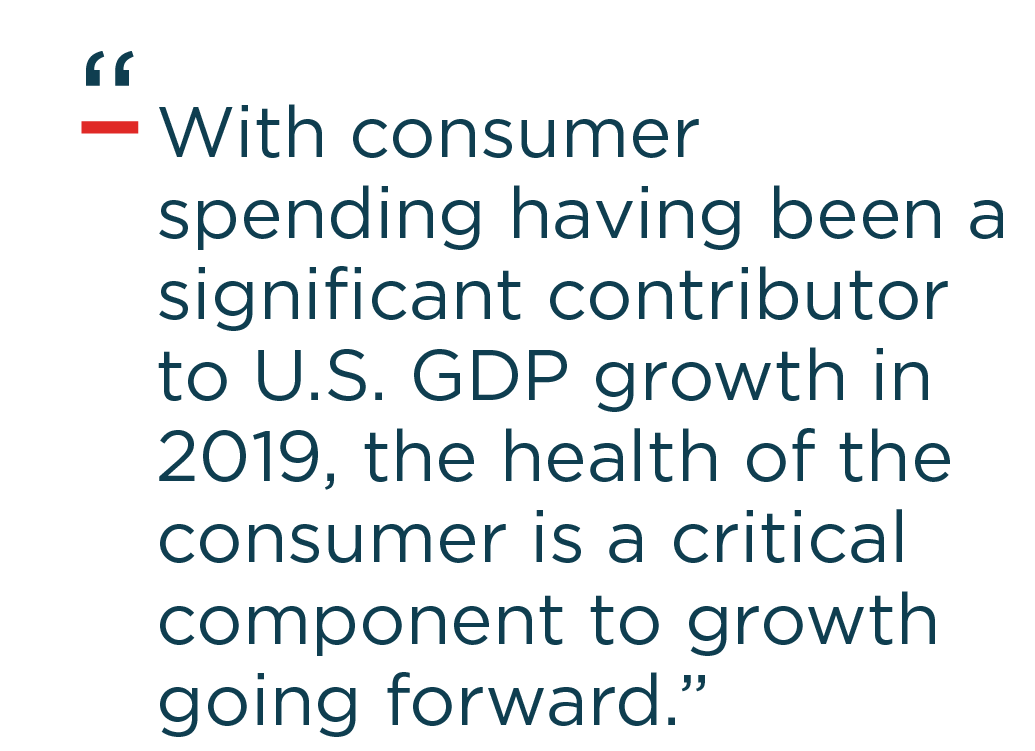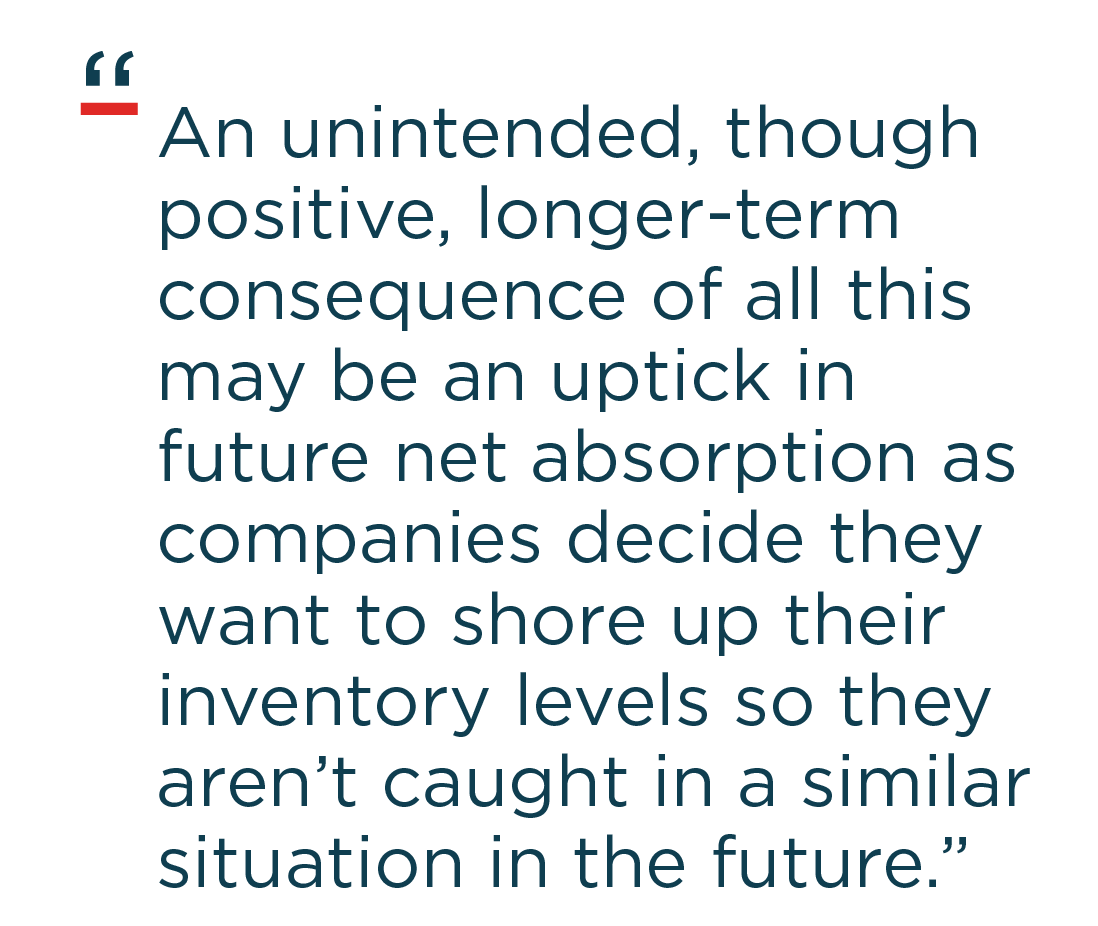Research Insights, March 20, 2020
UPDATE - Coronavirus: Potential Impact on Real Estate
The COVID-19 strain, more commonly known as the coronavirus, has continued to rattle global markets since the first reports of the disease emerged in Wuhan, China on December 31, 2019. Since then, the virus has spread to more than one hundred and sixty countries (up from thirty-eight in late February) with the largest concentrations outside of China occurring in Italy, Iran and Spain. At the time of this update, the World Health Organization (WHO) was tracking more than 246,000 confirmed cases of the virus worldwide and attributed 10,040 deaths to the virus.
In less than a month’s time, commentary has shifted from a view on how the U.S. and global economies had sufficient bandwidth to withstand shorter-term impacts from the coronavirus to one of speculation on the depth of its disruption and its potential to induce more severe recessions. Stock trading was halted for the third time within minutes of the opening bell on March 16th amidst a downdraft of 11% in the DJ Industrial Average, the S&P 500 and the Nasdaq Composite, as investors remained concerned about the viability of central bank policy to ward off a COVID-19-induced recession. Meanwhile, concerns surrounding financial markets’ liquidity have also risen to the forefront, as tightening in the commercial paper market prompted the Fed to step in to ease large companies’ short-term funding needs.

The potential near-term impact of the virus is likely to be varied by industry, region, and ultimately, the trajectory of the disease’s spread over the coming weeks. The following is our quick take on the virus, our view of the potential impacts to global and U.S. growth, and how it might influence domestic real estate markets.
Coronavirus Context
The global death toll from the coronavirus has now surpassed that from influenza in the U.S., which accounted for 8,200 deaths in the 2019-2020 season1, prompting widespread response measures. The onset of the coronavirus has been marked by widespread quarantines essentially shutting down entire cities, exacerbating the impact beyond just those infected. The tragic loss of more than 10,000 lives to date brings additional gravitas to an already-serious epidemic, one we at ARA are highly sympathetic to.
As we have seen just in the three weeks since our initial piece was published, statistics are constantly evolving in situations such as these, making a commentary on outlook especially challenging. The trajectory of active cases2 globally had exhibited signs of improvement after peaking in mid-February, sparking some optimism that the spread of the virus was slowing; yet after a trough in early March, the number of active cases ramped back up in the last two weeks and stood at 85,603 as of March 15th (a 46% increase above the prior peak recorded on February 17th)3. Today more than half (53.5%) of cases worldwide have occurred outside mainland China, as the number of new cases in the country have continued to decline.
Impacts to Global Growth
One economic risk to the U.S. and global economies arising from COVID-19 is the domino effect of companies being unable to source necessary component materials from China amidst multi-week-long factory shutdowns and quarantines coupled with a steep drop-off in spending slowing demand for goods and services, in turn creating a need for short-term credit that has become increasingly expensive.
How does a factory shutdown in China adversely impact U.S. and global growth? While a bit of an oversimplification, it could hit on several fronts:

And while to date it has not yet materialized in the data (given the inability of regularly scheduled economic indicators to capture changes in real time), a more severe blow to consumers via shifts in sentiment and quarantines (either voluntary or mandated) is another key risk.
With consumer spending having been a significant contributor to U.S. GDP growth in 2019, the health of the consumer is a critical component to growth going forward. It remains to be seen whether the U.S. consumer will continue to spend via alternative channels or whether they will adopt more conservative spending habits, the latter of which could create a drag on mid-term GDP figures. Ultimately the severity of these forces will depend in part on how widespread the virus and the subsequent measures to curtail it becomes; already, many jurisdictions have implemented shelter-in-place orders, with more to come.

We believe that under present conditions the impacts are manageable, though not without shorter-term pains. When production returns, pent-up demand may even provide a boost to sales, in turn bolstering corporate earnings and confidence and negating the short-term impacts. A more severe pandemic scenario would have a greater adverse impact but could also be met with stronger pent-up demand on the back end serving to offset weakness – how? Consumers who had planned to acquire high-ticket items will not suddenly decide not to buy them; rather, they’ll defer these purchases, creating a “slingshot” recoil after the virus has been contained, ultimately keeping full-year growth on or near pre-virus estimates. However, this too will also depend on how long certain segments of the workforce remain unemployed and the extent to which hiring resumes once the worst of the pandemic has passed.
This balancing of near-term weakness by later-term recovery is not a unique perspective, though economists’ views on the size, shape and timing of the trajectory vary. The March UCLA Anderson Forecast reflects an expectation of a two-quarter hit to GDP growth in Q2/Q3, but for full-year figures to come in around 1.5%, while Goldman Sachs’ latest GDP estimates reflect a lowering of expectations for the U.S. in the first half of the year (0% growth in Q1 before contracting 5% in Q2) with a bounce back of 3% & 4% growth in Q3 and Q4, respectively. Goldman’s figures reflect an 80-basis point reduction from their prior full-year estimates, with 2020 growth coming in at 0.4%. Results from the March 2020 Wall Street Journal Economic Forecasting Survey reflect a wide range of expectations, with Q2 GDP growth forecasted as high as 2.8% or contracting by as much as 12.0%, although the average across respondents suggest forecasts for full-year growth are somewhere around 1.2%.
While the more severe of these ranges would no doubt sting, it isn’t implausible that there could be GDP growth for calendar-year 2020 – as a point of comparison, China’s quarterly GDP at the peak of the SARS outbreak contracted by 240 bps in Q3 2003, and official figures for that year still reflected 10.0% annual growth.
Real Estate Implications
For U.S. commercial real estate, the impacts of a prolonged infection period will vary considerably by sector and market. Markets that are more heavily reliant on Chinese tourism (such as San Francisco and New York hotels) will feel the effects the quickest, as revenue per available room (RevPAR) weakens amidst fewer foreign travelers. These markets may also see retail sales weaken, as Chinese travelers tend to be one of the highest-spend foreign visitors to the U.S. – yet recent developments in U.S. cities’ attempts to slow the spread of the virus via social distancing strategies will no doubt have wider-reaching implications for bars, restaurants and the more experiential retail that has, to date, largely evaded the broader headwinds in the retail industry. New York City Mayor Bill de Blasio’s executive order on March 15th that would limit restaurants, bars and cafes to take-out and delivery and force the closure of theaters, concert venues and nightclubs with no timeline for re-opening portends what could become a reality in many cities across the country; this will exacerbate stresses on a sector whose fundamentals have already been tested for some time and challenge sub-segments that were previously considered more defensive.
The office sector could be impacted to the extent that companies miss their earnings meaningfully as a result of either product unavailability or broader financial market volatility and subsequently curb near-term leasing decisions until the uncertainty has passed. While this initially may impact tech-centric markets first, many companies’ goods are produced at least in part by components from China so the longer the impact period, the wider the impact net will be. Again, under current conditions, we believe the delay in decision making will be temporary; companies’ decisions to occupy office space are part of longer-term capital expenditure and growth planning and as a result are not often sidelined by near-term noise. While we could envision a scenario whereby select companies elect to employ broader remote work strategies in the wake of COVID-19 given the success during this “forced-trial” period, we do not believe this will represent a widespread departure from traditional office occupancy, but may accelerate trends in the way businesses leverage physical space.
While manufacturing PMIs have begun to soften amidst the pullback in Chinese factory output, the institutional industrial real estate sector has very little true manufacturing product in its composition, which is the segment that will feel the greatest and fastest impact of the coronavirus. Broader forces related to e-commerce and supply chain rationalization should continue to buoy demand for warehouse space in the medium- to longer-terms, in spite of manufacturing weakness; while West Coast port-centric markets such as Los Angeles/Long Beach may see activity pause given the heightened exposure to Asia Pacific imports, most major markets should continue to be relatively isolated. An unintended, though positive, longer-term consequence of all this may be an uptick in future net absorption as companies decide they want to shore up their inventory levels so they aren’t caught in a similar situation in the future.

The multifamily sector is domestically driven and as such, is the most insulated from a sector perspective; although nearer-term absorption may soften somewhat as more residents elect to renew in place, this may provide property owners an opportunity to maintain occupancy. We believe the risk to the multifamily sector will come via renters’ inability to pay rent amidst broad industry-specific layoffs; this will likely impact lower- and middle-income tenant bases first, though Class A product will likely not be immune.
Where previously we did not have sufficient visibility to opine on the potential impacts to transaction volumes, today we now know that commercial real estate market volumes have not been immune, though the regional variations in early data suggest greater impacts may be yet to come.
According to preliminary data from Real Capital Analytics, transaction volumes in Europe dropped 18% year-over-year through the first eight weeks of 2020 and were down 50% in Asia Pacific, yet Americas deal volume was 10% higher. With industry events curtailed for the time being and fewer investors able or willing to travel to see potential acquisitions, it is likely that U.S. volumes will moderate; this, coupled with the need for investors to reconsider pricing in light of the recent Fed movements and re-evaluate risk profiles may force would-be buyers into a holding pattern.
Summary
The world continues to grapple with the sudden and extensive eruption of the coronavirus, and the loss being experienced across the world is having a tragic impact on human life and the global community as a whole. This pandemic could have significant ramifications for the global economy and global supply chains, and with the myriad of possible outcomes changing daily as new information flows in, investors face uncertainty. While we at ARA are by no means epidemiologists, we believe there are a few positive signs beginning to emerge, including
- A decline in the number of new infections in China.
- More Chinese factories coming back online.
- Work resumption rate in China is rising.
Given the interconnectivity of major economies around the world, there is hope that central banks and governments’ coordinated efforts to stabilize credit markets, maintain liquidity and lift economies hit by the coronavirus will prove effective at offsetting shorter-term impacts. We believe that there is upside potential in the event that output lost as a result of near-term weakness may be recovered on the other side through consumption and business earnings rebounds after the trough, though when that will be is uncertain and risks remain skewed to the downside for the immediate future. In either scenario, we intend to maintain flexibility to pursue opportunities that align with our stated core and value-add strategies while mitigating risk.
1World Health Organization
2Active cases are calculated as total cases less mortalities and recoveries
3Worldometer
